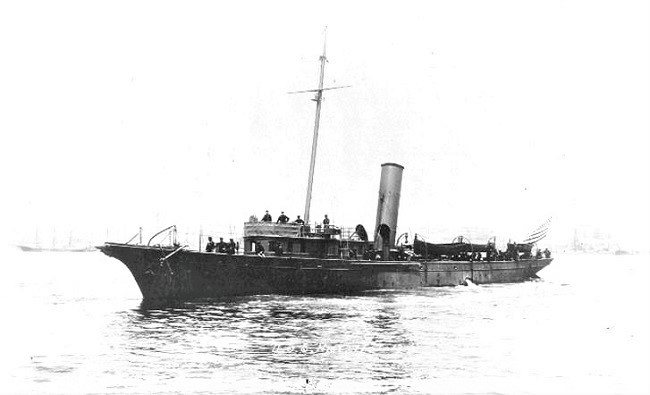


Once Cervera's squadron was
located and blockaded in Santiago harbor, HIST was no longer needed as a
coastal patrol vessel and was sent to Cuba,
arriving at Guantanamo Bay on June 25. The vessel joined the Santiago
blockade four days later. On June 30, in company with the U.S.S. HORNET,
captured the Spanish schooner NICKERSON, taking it as a
prize. Joined by the U.S.S. WOMPATUCK, the three vessels proceeded
to Manzanillo where they were involved in an intense skirmish with
Spanish defenders lastling over an hour and a half. The result was that
the Spanish lost a gunboat, a pontoon vessel, and a sloop transporting
troops as well as suffering damage to several torpedo boats and
gunboats. The American force had no casualties, though the HORNET was
disabled and had to be towed by the WOMPAUCK. HIST had been hit eleven
times. It was assumed that the Spanish suffered significant loss of
life.
On July 3, 1898, at the Battle of Santiago, the HIST rescued 142 Spanish sailors from the flaming wreckage of the Spanish cruiser VIZCAYA. On July 11, HIST, working with the WOMPATUCK, cut the communications cable between Punta Carapacho and Cayo Obispo. On July 15 HIST returned to Manzanillo successfully attacking the Spanish vessels there. In this action, ten Spanish vessels were destroyed and others damaged. On July 21, HIST bombarded Santa Cruz. On August 12, the day that the armistice was agreed to between the U.S. and Spain ending the fighting, HIST again attacked Manzanillo, with similar success as she had had previously. For her actions against Manzanillo, HIST received a commendation from Cuban General S. H. Rios for its actions.
Following the war, U.S.S. HIST was decommissioned at Key West on
February 2, 1899. She was recommissioned at Newport, Rhode Island
on July 18, 1902 under the command of Lt. Victor Blue. The
vessel served in the Caribbean until February 4, 1903. She next served
briefly in conjunction with testing of new submarines in Long Island
Sound. Beginning on June 27 HIST was assigned to serve as a tender
operating out of Newport. Later she served as the tender to the U.S.S.
CONSTELLATION until HIST was decommissioned on May 3, 1907. After being
recommissioned later the same year, HIST served as a tender to the 2d
Submarine Division, then was involved in a surveying expedition.
HIST was decommissioned for the last time on July 24, 1911 at
Portsmouth, Virginia. She was stricken from the Navy Register three days
later. The vessel was sold on November 20, 2011.
| Classification: | Patrol Boat | |
|---|---|---|
| Launched: | June 13, 1895 (as yacht THESPIA) | |
| Commissioned: | May 13, 1898 | |
| Rig: | Schooner rig | |
| Armament: | One 3 pounder rapid fire guns | |
| Four 1 pounder rapid fire guns | ||
| One Colt revolving cannons | ||
| Contractor: | William Cramp and Sons, Philadelphia | |
| Length: | 174 feet | |
| Beam: | 23 feet | |
| Mean draft: | 9 feet 10 inches | |
| Displacement: | 472 tons | |
| Complement: | 6 officers and 50 enlisted men, under the command of Lt. Lucien Young. | |
| Engine type: | Vertical compound engine driving a single screw, and capable of generating 500 horsepower | |
| Boiler type: | six single-ended cylindrical boilers | |
| Coal Bunker Capacity | 60 tons | |
| Speed: | 14.5 knots | |
| Armor: | Unarmored |
Clerk of Joint Committee on Printing, The Abridgement of Message
from the President of the United States to the Two Houses of Congress.
(Washington: Government Printing Office, 1899) Vol II.
"Coaling to Utmost Capacity," Boston Globe. May 19, 1898, 7.
"Coast Patrol Fleet," The Sun (Wilmington, DE). May 1, 1898,
7.
Dictionary of American Naval Fighting Ships. Vol. III (Washington: Navy Department, 1977) 335.
"The Thespia Launched," The Courier-News (Bridgewater, NJ).
June 13, 1895, 3.
"War News Notes," Smith County Pioneer (Smith Centre, KS). May
28, 1898, 7.